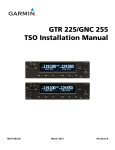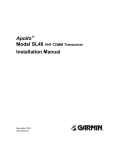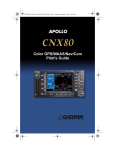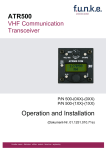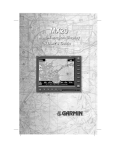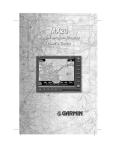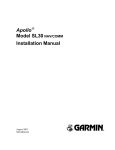Download SL30 Nav Comm User's Guide 5600403-01 Rev B
Transcript
© 2003 Garmin Ltd. or its subsidiaries. All rights reserved. Printed in the U.S.A. Garmin International, Inc., 1200 East 151st Street, Olathe Kansas 66062, U.S.A. Tel: 913/397.8200 Fax: 913/397.8282 Garmin (Europe) Ltd., Unit 5, The Quadrangle, Abbey Park Industrial Estate, Romsey, Hampshire S051 9DL, U.K. Tel: 44/1794.519944 Fax: 44/1794.519222 Garmin Corporation, No. 68, Jangshu 2nd Road, Shijr, Taipei County, Taiwan Tel: 886/02.2642.9199 Fax: 886/02.2642.9099 Garmin AT, Inc., 2345 Turner Road, S.E., Salem, OR 97302, U.S.A. Tel: 800/525.6726 Fax: 503/364.2138 Canada Tel: 800/654.3415 International Tel: 503/391.3411 Cage Code: 0XCJ6 Visit our web pages at www.garmin.com and www.garminat.com Send comments about this manual by email to: [email protected] Except as expressly provided herein, no part of this manual may be reproduced, copied, transmitted, disseminated, downloaded or stored in any storage medium, for any purpose without the express written permission of Garmin. Garmin hereby grants permission to download a single copy of this manual and of any revision to this manual onto a hard drive or other electronic storage medium to be viewed for personal use, provided that such electronic or printed copy of this manual or revision must contain the complete text of this copyright notice and provided further that any unauthorized commercial distribution of this manual or any revision hereto is strictly prohibited. Information in this document is subject to change without notice. Garmin reserves the right to change or improve their products and to make changes in the content of this material without obligation to notify any person or organization of such changes or improvements. Garmin®, Garmin ATTM, II Morrow, Apollo, and GNS are trademarks of Garmin Ltd. or its subsidiaries. These trademarks may not be used without the express permission of Garmin. Welcome ... Welcome ... Welcome to a new era of aviation communication and navigation. Once again, Garmin AT, Inc. has set new standards in features and ease of use for the general aviation public. The SL30 is a VHF Navigation/Communications Transceiver for use by the aviation pilot. The SL30 is packaged in a slim form factor that helps you get the most out of limited panel real estate without limiting features and performance. The SL30 is unequaled in providing the features, level of performance, and reliability that aviation users expect. The high performance Digital Signal Processing (DSP) filter design of the SL30 allows it to track weaker VOR signals with more accuracy than conventional analog receivers. Add additional features like Morse code Station Identification and Multiple VOR tracking and you begin to understand the Advantages of DSP in a VOR Navigation System. The use of DSP technology in the SL30 provides a state-of-the -art device, which packs more performance in less space for less cost. You can be confident in knowing that you are the owner of the state-of-the-art in aviation communication and navigation. Our products are built to last and to allow the flexibility to meet your needs as they change in the future. i Welcome ... History of Revisions Date November 1999 February 2000 August 2001 August 2003 November 2003 Software Version 1.0 1.1 1.2 Manual Revision Original Release Rev -00a Rev -01 Rev -01a Rev-01b Ordering Information To receive additional copies of the SL30 User’s Guide, order part #560-0403-xx. The SL30 Installation Guide is part #560-0404-xx. The Quick Reference Guide is part #561-0262-xx. About This Manual Please take a few moments to review the various sections in this manual. Even if you are an experienced user of Nav/Comms, be sure to read our Getting Started section. This section provides the rules for successful use of the SL30. The rest of the manual contains important information that you can refer to as you need more detail on specific procedures or features. The SL30 advances the technology of Nav/Comms and uses new state-of-the-art features you will want to know about. Welcome Introductory statement, History of Revisions, and manual Ordering Information. Getting Started Learn the rules for using your SL30. Advanced A detailed encyclopedia of the functions available in the Operation SL30 including step by step directions. Appendix Troubleshooting, Specifications, and Index. ii Table of Contents Welcome ... . . . . . . . . . . . . . . . . . . . . . . . . . . . . . . i History of Revisions . . . . . . . . . . . . . . . . . . . . . . . ii Ordering Information . . . . . . . . . . . . . . . . . . . . . . ii About This Manual . . . . . . . . . . . . . . . . . . . . . . . ii Getting Started . . . . . . . . . . . . . Display . . . . . . . . . . . . . . . Controls . . . . . . . . . . . . . . Operation Summary. . . . . . . . Power On . . . . . . . . . . . Selecting a Comm Frequency Selecting a NavFrequency . . System Mode . . . . . . . . . OBS Mode. . . . . . . . . . . Recalling Frequencies . . . . Emergency Channel . . . . . . . . . . . . . . . . . . . . . . . . . . . . . . . . . . . . . . . . . . . . . . . . . . . . . . . . . . . . . . . . . . . . . . . . . . . . . . . . . . . . . . . . . . . . . . . . . . . . . . . . . . . . . . . . . . . . . . . . . . . . . . . . . . . . . . . . . . . . . . . . . . . . . . . . . . . . . . . . . . . . . . . . . . 1 2 2 4 4 5 5 6 6 6 6 Advanced Operation . . . . . . . . . . . . . . . . . . . . . . . . . 7 Comm Radio Mode . . . . . . . . . . . . . . . . . . . . . . . 7 Monitoring the Standby Comm channel . . . . . . . . . 7 Saving a Comm channel . . . . . . . . . . . . . . . . . . 7 Removing a Comm channel . . . . . . . . . . . . . . . . 8 Changing or Replacing a Saved Comm Channel. . . . . 8 Recalling Comm Channels. . . . . . . . . . . . . . . . . 9 Emergency Channel. . . . . . . . . . . . . . . . . . . . 11 Stuck Mic. . . . . . . . . . . . . . . . . . . . . . . . . . 12 Intercom Function. . . . . . . . . . . . . . . . . . . . . 12 Nav Radio Mode . . . . . . . . . . . . . . . . . . . . . . . . 13 Monitoring the Standby Nav channel . . . . . . . . . . 13 Using the Standby Channel to Monitor a Second VOR 13 Listening to the Audio channel. . . . . . . . . . . . . . 16 Automatic Morse Code Decode/Display. . . . . . . . . 16 Saving a Nav channel . . . . . . . . . . . . . . . . . . . 17 Removing a Nav channel . . . . . . . . . . . . . . . . . 17 iii Recalling a Nav channel DST Data Display. . . . OBS Mode . . . . . . . . To/From Radial . . . . . System Mode . . . . . . . . . System Info. . . . . . . . Nav Options . . . . . . . Comm Options . . . . . VOR Equipment Test . . . . . . . . . . . . . . . . . . . . . . . . . . . . . . . . . . . . . . . . . . . . . . . . . . . . . . . . . . . . . . . . . . . . . . . . . . . . . . . . . . . . . . . . . . . . . . . . . . . . . . . . . . . . . . . . . . . . . . . . . . . . . . . . . . . . . . . . . . . . . . . . . . . . . . . . . . . 18 20 21 24 25 26 27 28 29 Appendix. . . . . . . . . . . . . . . . . . . . . . . . Troubleshooting . . . . . . . . . . . . . . . . . Installation Configurations . . . . . . . . . . . Specifications . . . . . . . . . . . . . . . . . . . General Features . . . . . . . . . . . . . . Comm Radio Features . . . . . . . . . . . Physical Specifications . . . . . . . . . . . NAV Radio Performance Specifications . . Comm Radio Performance Specifications . System Interfaces . . . . . . . . . . . . . . Localizer and Paired Glideslope Frequencies . VOR Station Frequencies . . . . . . . . . . . . . . . . . . . . . . . . . . . . . . . . . . . . . . . . . . . . . . . . . . . . . . . . . . . . . . . . . . . . . . . . . . . . . . . . . . . . . . . . . . . . . . . . 31 31 33 34 34 34 35 35 35 35 36 37 Index . . . . . . . . . . . . . . . . . . . . . . . . . . . . . . . . . 39 iv Getting Started Getting Started Combining a powerful 760 channel VHF communications transceiver with 200 channel VOR, Localizer and Glideslope receivers, the SL30 provides a full-functioned navigation and communications solution in a small footprint at a very affordable price. Besides traditional Nav/Comm features, the SL30 also incorporates workload-reducing functions such as automatic decoding of the Morse code station identifier for VOR/LOC, most-used frequency storage in memory, built-in course deviation indicator, and more. The SL30, the smallest Nav/Comm on the market, is loaded with features and functionality. The only Nav/Comm with the ability to monitor the standby Comm and Nav frequencies, the SL30 VHF Nav receiver operates from 108 MHz to 117.95 MHz decoding both the VHF Omni Range and Localizer navigation signals. The built in Glideslope receiver will automatically tune the corresponding glideslope paired frequencies (328 MHz to 335 MHz) when the localizer is tuned. The SL30 includes the powerful yet efficient 8 watt comm transmitter used in the other SL Slimline and GX avionics. Figure 1 - SL30 Front Panel Description 1 Getting Started Display The SL30 Nav/Comm uses a single line by 32-character 5x7 dot matrix alphanumeric display. A photocell is located in the top left corner of the front panel display. The photocell automatically controls the light intensity of the display LEDs from low brightness at night to high brightness during daylight operation. The lens is polarized to reduce reflections. Using polarized sunglasses may make it difficult to view the display. A transmit (TX) indicator located above the FLIP/FLOP button lights when the Comm radio is transmitting. TX Controls Power On/Off - Volume - Squelch PULL SQUELCH VOL OFF The knob on the left side of the SL30 controls power on/off, volume, and squelch test. Rotate the knob clockwise (CW) past the detent to turn the power on. Continuing to rotate the knob to the right increases speaker and headphone amplifier volume level. Rotate the knob to the left to reduce the volume level. Pull the knob out to disable automatic squelch. The SL30 may be configured to have the volume knob control Nav and intercom volume, as well as Comm volume . Large/Small knobs The dual concentric knobs on the right side of the SL30 are used to select frequencies, to view the features available within a function, or make changes. Details are provided in the appropriate sections. Flip/Flop Press the FLIP/FLOP button to switch between the active (left-most) and standby (right-most) frequency. Switching between Com frequencies is disabled while you are transmitting. COM 2 Comm Press COM to select the Comm radio mode. The annunciator will light above the button when you are in Comm mode. Press COM a second time to monitor the Getting Started Standby frequency. See the Advanced Operation section for more about monitoring frequencies. NAV Press NAV to select the Nav radio mode. The annunciator above the button will light when you are in Nav mode. Press NAV a second time to monitor the Standby frequency. See the Advanced Operation section for more about monitoring frequencies. NAV SYS Press SYS to reach the System mode. The annunciator above the button will light when you are in the System mode. SYS OBS Press OBS to see the current OBS setting and graphic CDI. If the annunciator above the OBS button lights, you may use the LARGE and SMALL knobs to change the displayed OBS values. OBS If your system is configured with an external CDI/HSI, the OBS radial of your remote display will be decoded and displayed on the screen of the SL30. T/F Press T/F to toggle between the bearing TO or radial FROM the active VOR. The T/F button does not operate for Localizer frequencies. T/F ID ID Press ID to select the Nav audio and toggle between VOICE or IDENT. Pressing ID will cancel the VOR monitor function. Selecting the monitor function will suspend the ID function until the monitor function is disabled. SEL SEL Press SEL to choose from a list of channel types or to change values. In Comm or Nav modes, press SEL to choose frequencies from the available lists. Press SEL again if you want to cancel the selection process. The 3 Getting Started annunciator will light above the button when this function is active. ENT Press ENT to save selected values, to confirm a prompt, or to save the Standby frequency. ENT Operation Summary Power On Turn the SL30 on. Either turn the Power/Volume knob clockwise to turn the power on or, if installed, turn on the master switch that powers the radios. The SL30 will go through a short initialization routine and then briefly display the last VOR check date. If you turn the SL30 off for less then 15 seconds and then back on, it will bypass the initialization process and return to the last used display. COM NAV SYS Comm Mode Nav Mode System Mode OBS Mode Large - MHz Large - MHz System Info Large - Tens of degrees Small - kHz Small - kHz Nav Options Small - ones of degrees Com - Monitor Nav - Monitor Com Options VOR Equip Test Figure 2 - Operation Summary 4 OBS Getting Started Selecting a Comm Frequency New frequencies are first selected as a Standby frequency and then toggled to the Active side when desired. While viewing the Standby frequency display, use the LARGE and SMALL knobs on the right side of the SL30 to select the desired frequency. 1. Press COM to reach the Comm radio function. The annunciator above the COM button will light. 2. Turn the LARGE knob to change the values in one MHz increments. The MHz selection range is between 118 and 136 in one MHz steps. 3. Turn the SMALL knob to change the values in 25 kHz increments. The kHz selection range is between 000 and 975 kHz in 25 kHz steps. Note that only two digits are displayed to the right of the decimal point. 4. Turn the LARGE and SMALL knobs clockwise to increase and counterclockwise to decrease the frequency values. Standby frequency selection is not inhibited during transmit. 5. Press the FLIP/FLOP button to toggle the Standby frequency to the Active frequency. Selecting a Nav Frequency The selection of Nav frequencies is the same as for the Comm frequencies. The annunciator above the NAV button will light. 1. Press NAV to reach the Nav radio function. 2. Turn the LARGE knob to change the values in one MHz increments. The MHz selection range is between 108 and 117 in one MHz steps. 3. Turn the SMALL knob to change the values in 50 kHz increments. 4. Press the FLIP/FLOP button to toggle the Standby frequency to the Active frequency. Note You cannot display both Nav and Comm frequencies at the same time. 5 Getting Started System Mode In the System mode you can view software versions, setup the Nav and Comm functions, and record VOR test information. See the Advanced Operations section for more details. OBS Mode Press the OBS button. If the annunciator above the button lights, then you may use the LARGE and SMALL knobs to adjust the Omni Bearing Selector. Recalling Frequencies In the Comm or Nav modes, press SEL to gain access to the available frequency lists of each mode. Turn the LARGE and SMALL knobs to view the available channels. 1. Press COM or NAV to go to the desired mode. 2. Press SEL to go to the frequency database. 3. Turn the LARGE knob to review the type of frequency. 4. Turn the SMALL knob to display the available channels in the selected type. 5. Press ENT to put the displayed channel into the Standby position or press FLIP/FLOP to put the displayed channel into the Active position. You can press SEL again to cancel selection. Emergency Channel The standard emergency channel (121.50 MHz) is stored in the Comm memory of the SL30. 1. Press COM, if you aren’t in Comm mode already. Press SEL. Turn the LARGE knob to the Emergency channel, one position counter-clockwise will reach it fastest. 119.10 s124.55 emrgncy 121.50 2. Press the FLIP/FLOP button to make the Emergency channel the Active channel. 3. Listen, or key the Mic to send your message. 6 Advanced Operation Advanced Operation Comm Radio Mode Monitoring the Standby Comm channel The Frequency Monitoring function allows you to monitor the Standby frequency for activity, while listening to the Active frequency. Press the COM key in the Comm function to listen to the standby frequency. A small “m” will replace the “s” in front of the Standby frequency. 119.10 m124.55 PDX from 115 When the Active frequency receives a signal, the unit will switch automatically to the Active frequency. The Active frequency quality is not affected. The Frequency Monitor function is turned off when you flip/flop frequencies, recall a frequency, or press COM again. Monitoring is not canceled by switching to Nav mode. Saving a Comm channel You can save the Standby frequency and give it a name of up to four characters. A combination of up to 250 Comm and Nav frequencies may be saved. After 250 Nav and Comm frequencies are saved, you will get a “Database Full” message. You will have to remove frequencies before any more can be saved. A frequency type can also be assigned along with the saved selection. Types available include: Tower (TWR), Ground Control (GND), ATIS (ATS), Air Traffic Frequency (ATF), Approach (APP), Arrival (ARR), Automated Weather Station (AWS), Clearance (CLR), Common Traffic Advisory Frequency (CTF), Departure Control (DEP), Flight Service Station (FSS), Remote Flight Service Station (RFS), Unicom (UNI), and Mandatory Frequency (MF). 7 Advanced Operation 1. While in Comm mode, press ENT. The right side of the display will show “store as” with a flashing cursor at the first character of the name. 119.10 s124.55 store as _ 2. Turn the SMALL knob to choose the desired character. 3. Turn the LARGE knob to move to the next character position. 4. After you turn the LARGE knob one position clockwise past the fourth character, three underscores at the end of the line will flash. 5. Turn the SMALL knob to choose the desired type. 6. Press ENT after making your selections. Press SEL if you do not want to save the frequency. Removing a Comm channel You may only remove channels stored in the User list. 1. In Comm mode, press SEL. 2. Turn the LARGE knob to the User list and then turn the SMALL knob to the desired channel. 3. Press SEL. “Remove?” will flash on the right side of the display. 119.10 s124.55 SLE ats Remove? 4. Press ENT to remove the channel from the User list or press SEL to exit without making changes. Changing or Replacing a Saved Comm Channel Channels you have saved in the User list may be changed or updated by replacing the frequency, but keeping the same name and type. 1. Note the name of the channel you want to change. You are going to use the same name and type for a new channel. 2. Turn the LARGE and SMALL knobs to display the desired Standby frequency. 3. Press ENT. The right side of the display will show “store as” with a flashing cursor at the first character of the name. 8 Advanced Operation 4. Use the LARGE and SMALL knobs to enter the previously used name and frequency type. 5. Press ENT. The previously used name and frequency are now replaced with your new entry. Recalling Comm Channels There are several lists of channels that you can recall from memory, they are: remote channels, the ten most recently used channels, user-stored channels, weather channels, and the emergency channel. The lists available depend on your installation. Pressing ENT selects this entry as the standby channel. Press the FLIP/FLOP button to select this entry as the active channel. Comm Stored Frequencies Press Remote Comm Frequencies SEL . Turn LARGE Knob Auto Stored List (AUTO) , then turn SMALL knob User Memory (USER) Weather First First First First Last Last Last Last Press ENT to insert into Standby. Press . Emerg. Channel to insert into Active. Figure 3 - Recalling Comm Frequencies Remote Comm Channel Lists Database information can be read when your SL30 is connected to another device, such as the SL60. Each remote list begins with a facility identifier, such as PDX, SLE, LAX, etc. The LARGE knob scrolls through the remote, and other, lists. The SMALL knob scrolls through the channels in each list. A diamond indicates that more channels are available for the displayed facility. 119.10 s124.55 PDX ats 128.35Y 9 Advanced Operation Automatic Comm Channel List (Autolist) The last ten used active frequencies are available separately for Nav and Comm channels (ten for Nav and ten for Comm). The channels are stored in chronological order beginning with the most recent used. Duplicates are not saved again, but they are moved to the front of the list. The SMALL knob is used to view entries in the list. 119.10 s124.55 autolist 119.10Y User Comm Channel List The Comm channels that you saved are in this list. In Comm mode you will see the channels you saved while in Comm mode. This list is arranged alphabetically by name. View the saved channels by rotating the SMALL knob. Press the FLIP/FLOP button to make the viewed channel the Active channel. Press the ENT button to make the viewed channel the Standby channel. 119.10 s124.55 10 SLE ats 124.55Y Advanced Operation Weather Channels The standard weather channels are stored in the memory of the SL30. You cannot transmit on a weather channel frequency. Weather channels are not available in all locations. Weather Frequencies 162.400 MHz 162.425 MHz 162.450 MHz 162.475 MHz 162.500 MHz 162.525 MHz 162.550 MHz 1. In Comm mode, press SEL. Turn the LARGE knob to the Weather channels. 119.10 s124.55 weather 162.40Y 2. Turn the SMALL knob to choose the desired weather channel. 3. Press the FLIP/FLOP button to make the selected weather channel the Active channel. Emergency Channel The standard emergency channel (121.50 MHz) is stored in the memory of the SL30. 1. Press SEL. Turn the LARGE knob to the Emergency channel. 119.10 s124.55 emrgncy 121.50 2. Press the FLIP/FLOP button to make the Emergency channel the Active channel. 11 Advanced Operation Stuck Mic The SL30 helps protect you from a situation where the microphone may get stuck in the ON or Transmit position. If the microphone is keyed for longer than 35 seconds, the SL30 will return to the receive mode on the selected frequency. A “Stuck Mic” message will display until the transmit key is released. Note In an emergency situation, if the “Stuck Mic” message remains after you have stopped keying the mic, turn the power off and then back on. You will then get another 35 second time-out period to transmit. Intercom Function When two headphone and microphone jacks are connected to the SL30. Headsets can be used in conjunction with the internal voice-activated intercom. When you select the Intercom function with the installed selector switch, the intercom function is enabled. The Volume control may control the headphone listening level. See the System Mode information for setting up the Mic squelch, transmitting mic, and Intercom volume. 12 Advanced Operation Nav Radio Mode Monitoring the Standby Nav channel The Nav radio provides a monitor function for VORs as the standby channel similar to the Comm radio. The monitor function is activated or deactivated by pressing the NAV button while in the Nav function. The From radial for the standby channel is shown in parentheses when the VOR monitor mode is activated. This replaces the station identifier, OBS course, or VOR/LOC indicator. A small “m” will replace the “s” in front of the Standby frequency. The Standby VOR radial is updated once per second. You cannot monitor a Localizer channel. 111.80 m117.40 (267) from 115 If no signal can be tracked on the standby channel, then it will be dashed out. 111.80 m115.40 (---) from 115 The VOR Monitor function is turned off when you flip/flop frequencies, recall a frequency, or press NAV again. Monitoring is not canceled by switching to Comm. Using the Standby Channel to Monitor a Second VOR You can use the monitor function of the Standby channel as if it were a second Nav receiver. This is useful to check for crossing points on the course you are navigating along. The two following examples show how to monitor the second channel. You can use these examples to develop your own solutions for other in-flight navigation needs. 13 Advanced Operation Navigating along a Back Course approach 1. Press NAV to select the Nav receiver. 2. Set the Localizer frequency of your approach as the Active channel. 3. Press SEL. The display will prompt you to enable the back course. Press ENT to enable the back course. Press SEL and ENT again to disable the back course when it’s appropriate. When Back Course is enabled, it is noted by “bc” on the display. 4. Set the Standby channel to the appropriate VOR and note where a radial crosses the FAF and MAP for your approach. Press NAV a second time to “monitor” the Standby channel. A small “m” will replace the “s”. 5. The internal CDI (on the right side of the display) and the external CDI, if installed, will guide you along the course to the runway. 6. The radial of the Standby channel you are monitoring will be shown in parentheses to the right of the Standby channel. 7. Use the monitored Standby channel to note your location along the approach. Figure 4 - SL30 as two Nav receivers to locate the FAF and MAP 14 Advanced Operation Navigating to a MAHP 1. Press NAV to select the Nav receiver. 2. Set the VOR frequency for the radial you are following to the MAHP as the Active channel. 3. Set the Standby channel to the appropriate VOR and note where a radial crosses the MAHP for your runway. Press NAV a second time to “monitor” the Standby channel. A small “m” will replace the “s”. 4. The Active channel will drive the internal CDI (on the right side of the display) and the external CDI, if installed. 5. The radial for the Standby channel you are monitoring will be shown in parentheses to the right of the Standby channel. 6. Use the monitored Standby channel to note your location along the path to the MAHP. You will be at the MAHP when the Standby channel displayed radial matches the target radial. Figure 5 - SL30 as two Nav receivers to locate a point 15 Advanced Operation Listening to the Audio channel The audio for the active Nav channel is toggled between modes using the ID button. The annunciator above the button will light while Nav audio is activated, and the detected audio signal will be sent to the Nav audio output circuit. Nav audio may also be mixed with the Comm audio output, if selected in the System mode. When you are monitoring a VOR, Nav audio is suspended. There are three modes for the Nav audio. Press the ID button to start the ID mode. “IDENT” will be displayed for three seconds. The Morse code tones sent over the VOR/Localizer channels will be heard. If the ID button is pressed a second time. “VOICE” will be displayed for three seconds. The Morse code tone volume will be reduced so you can hear the voice transmission more clearly. Press ID again to turn the audio and ID annunciator off. The last audio output selection is kept in memory until you change it, even when the SL30 is powered off. Using this feature, you may leave the audio enabled and then control it by an external audio panel. Automatic Morse Code Decode/Display The Morse code identifier will not be available until two messages have been successfully received, which may take from 15-60 seconds depending on conditions. When no voice is present on the station, the Morse code identifier is decoded correctly at least 99.5% of the time. If the station is transmitting voice along with the Morse Code identifier, the probability of the SL30 to decode the identifier drops to 95%. Voice or poor reception (such as the station is far away) may delay or inhibit the automatic decode function. 16 Advanced Operation Saving a Nav channel You can save the frequency in the Standby position and give it a name of up to four characters. Additional information can be saved along with the name, if the selection is a Localizer or ILS. ILS selections may include the runway number (01-36) and designation (L, R, or C). Up to 250 Comm and Nav frequencies may be saved. After 250 Nav and Comm frequencies are saved, you will get a “Database Full” message. You will have to remove frequencies before any more can be saved. 1. While in Nav mode, press ENT. The right side of the display will show “store as” with a flashing cursor. 108.10 s111.10 store as _ ils 2. Turn the SMALL knob to choose the desired character. 3. Turn the LARGE knob to move to the next character position. 4. If it is a Localizer frequency, after you turn the LARGE knob one position clockwise past the fourth character, the LOC label will flash. 5. Turn the SMALL knob to choose the runway number (01-36). 6. Turn the LARGE knob one position clockwise. An underscore will flash. Turn the SMALL knob to choose L, R, or C to identify the runway, as desired. 7. Press ENT after making your selections. Press the SEL button if you do not want to save the frequency. Removing a Nav channel You may only remove channels stored in the User list. 1. In Nav mode, press SEL. 2. Turn the LARGE knob to the User list. Turn the SMALL knob to the desired channel. 3. Press SEL. “Remove” will flash on the right side of the display. 4. Press ENT to remove the channel from the User list. You may also press SEL again to cancel the process. 17 Advanced Operation Recalling a Nav channel There are several lists of channels that you can recall from memory in Nav mode. Remote Localizer, remote VORs, the ten most recently used channels in Nav mode, and the user-stored channels. 1. In Nav mode, press SEL. 2. Turn the LARGE knob to the desired list. 3. Turn the SMALL knob to view the available channels in each list. 4. Press ENT to select the entry as the standby channel. Press the FLIP/FLOP button to select this entry as the active channel. NAV Stored Frequencies and DST Data* Press Remote ILS Frequencies SEL . Turn LARGE Knob Remote VOR Frequencies , then turn SMALL knob Auto Stored List (AUTO) First First First First Last Last Last Last Press ENT to insert into Standby. Press Figure 6 - Recalling stored Nav channels 18 User Memory (USER) to insert into Active. . Distance Speed Time Data * Shown when installed external device is sending data Advanced Operation Remote Localizer List If Localizer channels have been sent by an external device, then this list will be the first displayed for convenience while preparing for a landing. The list shows the airport identifier on the left, a runway identifier for the station in the center, and the channel frequency on the right. If multiple Localizer frequencies are available at the destination airport, a Y will be shown on the right side of the display. The SMALL knob will scroll through the entries in the order they were sent. 111.80 s117.40 PDX 10L 111.30Y Remote VOR list If VOR channels have been sent by a remote device, then this list will be the next available. The channels show the identifier, the “vor” label, and the frequency. 111.80 s117.40 UBG vor 117.40Y Automatic Nav Channel List The last ten used active frequencies are available. The channels are stored in chronological order beginning with the most recent used. Duplicates are not saved again, but are moved to the front of the list. 111.80 s117.40 autolist 111.80Y Nav User Channel List The Nav channels that you saved are in this list. This list is arranged alphabetically by name. Selection is simply by means of rotating the SMALL knob to view the channels. 110.10 s113.00 UBG vor 117.40Y 19 Advanced Operation DST Data Display When the SL30 has received data from an external device, such as a DME sensor, through the serial port, DST data is added to the Nav recall list. If you aren’t connected to an external sensor, you will not see this display. If the display of Distance-Speed-Time (DST) data is not activated, you will be prompted to show the data when you view the DST selection in the channel recall lists. 109.90 s117.40 99.9i 111j 0:54 Distance from station in nautical miles Ground speed relative to station in knots Estimated time to station in hours and minutes Figure 7 - DST display description Enable DST Data Display 1. In Nav mode, press SEL. Then, turn the LARGE knob to the DST Data list. 111.80 s117.40 show dst data? 2. Press ENT to enable the display of DST data. DST information will now replace the Nav information on the Nav mode display. 111.80 s117.40 99.9nm 111kt 0:54 Disable DST Data Display 1. In Nav mode, press SEL. Then, turn the LARGE knob to the DST Data item. 111.80 s117.40 remove dst data? 2. Press ENT to disable the display of DST data. The DST data display may be deactivated by pressing either T/F or OBS in addition to the “Remove DST Data?” screen. 20 Advanced Operation OBS Mode OBS Operation OBS mode enables the VOR CDI which is displayed on the right side. The OBS course setting is shown in the center of the display. The OBS button is used to select this mode. If OBS mode is allowed in the unit’s installed configuration, the annunciator over the OBS button will light. The knobs adjust the OBS setting in this mode rather than the frequencies. The LARGE knob adjusts the course by tens (00-35 in higher digits). The SMALL knob adjusts single degrees. OBS Direct-To You can navigate Direct-To a VOR. In Nav mode with a VOR as the Active frequency, press OBS twice. The CDI will now center in the TO condition. OBS Mode Disabled If the active frequency is a localizer, OBS mode is not available. Instead, the CDI is always displayed with loc appearing to its left. OBS mode and the CDI display for VORs are not available if the SL30 is installed with an indicator head that uses a composite converter. CDI A CDI display is also available for VORs. The OBS course setting is displayed to the left of the CDI. The CDI graphic is dashed and marked “flagged” when no signal is received. If you enabled the “Display Ident over OBS” selection in System mode, the Morse code station identifier will replace the OBS value when it receives the identifier message. fr A}}} 111.80 s117.40 120 111.80 s117.40 120 ---flagged--- 21 Advanced Operation The CDI display is selected by pressing the OBS button. The CDI display is not available if the SL30 is set to use an external indicator head that does not provide a resolver input. The graphic CDI shows an airplane icon at the center that points up in the To condition or down for From. An area of ambiguity exists when you are on radials that are more than 85° off the OBS course setting. When you are within this range, the airplane icon will be replaced by the “+” symbol. OBS Setting From 85º VOR + 85º To Figure 8 - Cone of Ambiguity The SL30 graphic CDI is shown as a bar graph of up to five pairs of short and tall bars right or left of the icon. Each short and tall bar pair indicates two degrees deflection. The short bar alone shows partial progress towards a full two degrees. Fly towards the bars to be on course, except in Back Course mode. When you see only the airplane icon you are on course. Additional information may be displayed on the clear side of the CDI. This optional information is selected in a system menu and includes a A} to or from indicator, a numeric representation of the deflection in tenths of degrees, or nothing at all. Note that TO Indication 22 2º Deflection Advanced Operation the additional information only switches sides after the CDI deflection has exceeded two degrees on the side that is currently used. Localizer A localizer (ILS) frequency is distinguished from the VOR OBS display by the label, “loc,” to the left of the CDI rather than the OBS course. If the back course is selected, then “bc” will appear as additional information. The “loc” label is replaced by the station’s Morse code identifier after it is decoded. The CDI display will be dashed and marked flagged if no signal is detected on the active channel. 109.90 s117.40 loc A}} Back Course When a localizer channel is active and the SL30 is in Nav mode, the SEL button will bring up a prompt to enable or disable the Back Course mode. The ENT button will enable the Back Course mode. The LARGE knob will still scroll through the recall lists. Back Course mode is not available if the SL30 is set to use an external indicator head with a built-in VOR/LOC converter. When you set up the Back Course approach in your SL30, no additional setup is required for your HSI or autopilot. The SL30 corrects the Left/Right deviation indications to your HSI and autopilot, if they are coupled to the SL30. In addition, the Glideslope indicator will be flagged and the needle will be centered. This will make the Back Course approach easier since false or misleading glideslope information is not displayed. SL30 1) Press NAV and then set the appropriate Localizer channel into the Active position. 2) Enable the Back Course. Press SEL and then ENT. 111.10 s116.00 Enable backcrs? 23 Advanced Operation 3) The SL30’s internal CDI will show “BC” and the external CDI annunciator will show “BC.” 111.10 s116.00 loc bc +}} 4) Make sure you are flying a Back Course approach, because the CDI is now reversed so you can still “chase” the needle. HSI Do NOT select the reciprocal inbound course. The SL30 will automatically send the correct left/right deviations to your connected HSI. Autopilot Do NOT select Back Course in your autopilot if it is connected to the SL30. The SL30 will automatically send the correct information to your connected autopilot. To/From Radial The VOR radial display shows the To/From radial computed by the active channel’s signal as well as the Morse code channel identifier decoded from the received audio. If no signal is received, the bearing will be dashed. Until the identifier is decoded, “vor” will be displayed. 112.80 s117.40 vor from --- 112.80 s117.40 PDX from 115 The T/F button selects the To or From radial display. If the VOR radial display is not currently shown, press T/F to show the radial display. When the VOR radial is displayed, pressing T/F will toggle between the Bearing To and Radial From the VOR. This button is not functional if a localizer frequency is selected on the active channel. 24 Advanced Operation System Mode Configuration adjustments for the SL30 are made in the System mode. When you press the SYS button, the annunciator above the button will light, and the display will change to the System mode menus. The menus available are: l System info l Nav options l Comm options l VOR equipment test Press System Info Software Versions SYS . Turn LARGE Knob Nav Options , then press ENT . Comm Options VOR Equipment Test Nav Audio Level RF Signal Level Date of Last Test Nav/Com Mix Level Com Noise Level Type of VOR Test Low Display Intensity Additional CDI Info Mic1 Squelch Location High Display Intensity Display Ident over OBS Mc2 Squelch Bearing Error Transmit Using... First Name Intercom Level Last Name Sidetone Level Headphone Level Figure 9 - System Mode Summary 25 Advanced Operation System Info System Info provides information about the Software versions and the Display Intensity. 1. Press SYS and turn the LARGE knob if necessary to the System Info page. Press ENT. 2. Turn the LARGE knob to view the selections. Software Version The Software version is available for reference when you contact Technical Support. 1. In the System Info function turn the LARGE knob to Nav software version. 2. Turn the SMALL knob to view the Nav, Com, and DSP software versions. Low and High Display Intensity As it arrives from the factory, the SL30 automatically adjusts its display brightness for the current lighting conditions. A small sensor at the upper left of the display is used for this function. There are two adjustments available for controlling the brightness level of the display. The first controls the lower brightness level in the automatic adjustment range (Low Display Intensity). This is the brightness used when in total darkness. The second adjusts the upper limit of this range (High Display Intensity). This is used when bright light is shining on the display. The factory settings for these are at the limits of the range, 0 (Low Display Intensity) and 100 (High Display Intensity). The range can be adjusted by using the SMALL knob to adjust the two values. Some users may wish to disable the automatic dimming function. This can be accomplished by setting the high display level to zero. Now the low level adjustment will set the brightness of the display directly with no automatic adjustment made based on ambient light. 26 Advanced Operation Nav Options Nav Audio Level This setting is for the SL30’s output to its external audio panel. The factory default value is “Variable”, which slaves it to the volume knob. The range of values it can be set to are 1 to 100. Nav/Comm Mixing Level The Nav audio output may be mixed with the com audio output for installations without an audio panel. The default value is “Disabled”. The manual adjustment range is 1 to 100. This scale actually represents a level relative to that of the Comm audio. Additional CDI Info You may optionally select one of a couple of pieces of information to display on the empty side of the VOR CDI. This page allows the user to select this. The options are to leave it blank (None), display a To/From indication, or display a numeric value of the deviation (Numeric). The numeric deviation is displayed from 0 to 85º with a maximum resolution of 0.1º. Display Ident over OBS This is a simple “yes/no” selection. If it is set to No, then the OBS course will always be displayed to the right of the CDI when displayed except when the monitor function is enabled. If this option is set to yes, the Morse code station identifier will replace the OBS course after it is decoded. 27 Advanced Operation Comm Options The Comm Options selection allows you to set up options available for Comm radio operation. 1. In the System mode rotate the LARGE knob to display the Com Options page. Press ENT. 2. Rotate the LARGE knob to view the Com Options RF Signal Level The RF Level function shows the relative signal strength of the active frequency. The value will change as signal conditions change. This information can be used by your dealer to adjust the radio squelch break. Comm Noise Level The Comm Noise Level function shows the relative received noise level of the active frequency. The value will change as signal conditions change. Mic 1 and 2 Squelch The input levels required to break squelch by the microphones are set by these values. Lower numbers indicate a higher input level necessary to break squelch. Turn the LARGE knob to view Turn the SMALL knob to change the value. The range is from 0 to 100. Transmit Mic The Transmit Microphone page allows you to control which microphone is permitted to transmit. You may choose Mic 1, 2, or both. To adjust the Transmit Mic control: 1. In the Com Options selection, rotate the LARGE knob to display the Transmit Mic page. 2. Rotate the SMALL knob to select MIC1, MIC2, or MIC1+MIC2. 3. Select an appropriate frequency, key the transmitter, and talk into the microphones to check for the intended operation. 28 Advanced Operation Intercom Level This function adjusts the Intercom Audio Level. Turn the SMALL knob to change the value. The range is from 1 to 100. Setting the value to “variable” slaves the intercom level to the volume control knob. Sidetone Level This function displays and adjusts the sidetone audio level that is heard when the transmitter is keyed. Turn the SMALL knob to change the value. The range is from 1 to 100. Setting the value to “variable” slaves the sidetone level to the volume control knob. Headphone Level The Headphone Level function allows you to adjust the headphone audio level. Turn the SMALL knob to change the value. Setting the value to “variable” slaves the headphone audio level to the volume control knob. The range is from 1 to 100. VOR Equipment Test This menu allows you to record information about the most recent equipment check performed on the unit as required for IFR flight. You may include information about: Date of Last Test, Type of VOR Test, Location, Bearing Error, First Name, and Last Name. 1. Press SYS to reach System mode and then turn the LARGE knob to the VOR Equipment Test function. Press ENT. 2. Turn the LARGE knob to the desired item. 3. Press SEL to enable editing. The LARGE knob moves the cursor and the SMALL knob adjusts the value at the cursor. Press ENT to save the values you selected. Press SEL to abort editing. 4. Repeat steps 2 and 3 for all the desired information areas. 5. Press COM or NAV to leave the System mode. Press SYS to go back to the main System mode menu. 29 Advanced Operation Notes 30 Appendix Appendix Troubleshooting If efforts to resolve the problem fail, contact your dealer or the factory for technical assistance. The Garmin customer service staff will gladly assist you. Please have the following information ready: l System configuration (products, antennas, mounting locations, etc.) l Model No., part number, and serial number l Software versions l Description of the problem l Efforts made to isolate/solve the problem Garmin International, Inc. Customer Service Department 1200 East 151st Street Olathe, KS 66062-3426 USA (913) 397-8200 FAX (913) 397-8282 http://www.garmin.com 31 Appendix Problem SL30 does not power on Action No power to the SL30 Check power connections, breakers, and main avionics switch Faulty electrical wiring or connection Contact your dealer to perform electrical system test No Nav audio Output disabled or set to a low level Check System page, Nav options, Nav Audio Level Nav audio in Comm Mixed with Comm feature Check System page, Nav Options, Mix Nav Audio with Comm SL30 does not transmit Weather channel is selected Select a different frequency, transmit on Weather channel not allowed No power to Comm Check power connections Mic key connection Check Mic key input connection Sidetone level is too low or too high Wrong type of headsets, or level needs adjustment Check System page, Nav Options, Sidetone level Intercom doesn’t function Input not connected Check connections No voice activation, or must talk too loud Check System page, Com Options, Intercom level Can’t change active frequency Comm Radio not communicating Contact dealer OBS readout displays “---” Resolver failure Contact dealer Calibration error Recalibrate resolver Corrupted system calibration parameters Contact factory Display shows “Incorrect Calibration Checksum” at start-up 32 Possible Cause Appendix Installation Configurations Certain functions are either available or not depending on the configuration of your particular installation. The following table illustrates the features available for the described installations. A feature that is available is indicated by the black dot. VOR Monitor VOR CDI Display Localizer OBS Glide Back Mode/OBS Slope Info Course Direct-To See Note 1 StandAlone l l l External CDI/HSI resolver l l l l l External CDI/HSI resolver with VOR/LOC converter External serial CDI/HSI l l l l l Note 1 - External indicator must support vertical deviation indication to the pilot. 33 Appendix Specifications General Features 32 character high-intensity alphanumeric LED display Sunlight readable full alphanumeric display Automatic display intensity Back-lit buttons 200 channel memory (stored alphabetically) Remote frequency flip-flop input pin Navigation Radio Features 200 channel Nav with solid state DSP technology VOR/Localizer and Glideslope receivers Built-in VOR/Localizer converter Frequency range: VOR 108.00 – 117.95 MHz Localizer 108.00 – 111.95 MHz Glideslope 328.60 – 335.40 MHz Digitally decoded OBS setting Manual selection of back course approach Automatic display of station ID by decoding Morse code Interfaces to most CDI (w/resolver), HSI, and autopilot systems VOR receiver displays To or From radial of the active channel VOR monitor displays From radial of the standby channel Back course annunciator output LOC enable annunciator output Internal RF diplexor Active and standby flip/flop frequencies DME or other DST (Distance, Speed, Time) tuning an data display Comm Radio Features 760 communications channels Frequency range 118 to 136.975 MHz Active and standby flip/flop frequencies Volume control Tunes to National Weather Service broadcasts Transmit status indicator Frequency monitor function (listens to standby while monitoring active) Emergency channel menu Squelch test function Stuck Mic time-out 34 Appendix 12 watt audio amplifier Includes two-place VOX intercom Physical Specifications 1.3"(H) x 6.25" (W) x 10.5" (D) Weight 2.25 lbs. (unit only) Depth 11.452 inches (29.09cm) behind panel, including mounting frame and connectors NAV Radio Performance Specifications Input voltage range 10 to 40 VDC Operating temperature range –20ºC to +55ºC Certified TSO C34e/JTSO C34e (Glideslope receive) Certified TSO C36e/JTSO C36e (ILS Localizer receive) Certified TSO C40c/JTSO 2C40c (VOR receive) Certified TSO C66c/JTSO 2C66b (DME display) Comm Radio Performance Specifications Input voltage range 10 to 40 VDC Operating temperature range –20ºC to +55ºC Transmit power 8 watts (Carrier Power) Certified TSO C37d/JTSO 2C37e (Comm transmitting) Certified TSO C38d/JTSO 2C38e (Comm receiving) Certified TSO C128/JTSO 2C128 (stuck mic) System Interfaces Navigation Receiver The SL30 can be installed in several configurations based upon individual requirements. This includes with or without an external course deviation indicator. The CDI may be discrete, serial, or composite. Comm Transceiver For standalone installations, the Comm requires connections to: a standard Comm antenna a microphone (or microphones) a speaker or headphone power input These items may be installed dedicated to the SL30 Comm, or by connection to an audio panel. The system can be configured to mix the NAV audio with the Comm audio if no external audio panel is used. Serial Interface DST or DME – Distance, Speed, Time or Distance Measure Equipment SL/GX – GPS products MX – Multi-Function Display 35 Appendix Localizer and Paired Glideslope Frequencies Localizer MHz Glideslope MHz Localizer MHz Glideslope MHz 108.1 334.7 110.1 334.4 108.15 334.55 110.15 334.25 108.3 334.1 110.3 335.0 108.35 333.95 110.35 334.85 108.5 329.9 110.5 329.6 108.55 329.75 110.55 329.45 108.7 330.5 110.7 330.2 108.75 330.35 110.75 330.05 108.9 329.3 110.9 330.8 108.95 329.15 110.95 330.65 109.1 331.4 111.1 331.7 109.15 331.25 111.15 331.55 109.3 332.0 111.3 332.3 109.35 331.85 111.35 332.15 109.5 332.6 111.5 332.9 109.55 332.45 111.55 332.75 109.7 333.2 111.7 333.5 109.75 333.05 111.75 333.35 109.9 333.8 111.9 331.1 109.95 333.65 111.95 330.95 Each displayed localizer frequency is paired with a glideslope frequency that is not displayed. 36 Appendix VOR Station Frequencies VOR stations occur every 50 kHz from 112.00 through 117.95 MHz and on the following frequencies in the 108 to 112 MHz band. 108.20 109.20 110.20 111.20 108.25 109.25 110.25 111.25 108.40 109.40 110.40 111.40 108.45 109.45 110.45 111.45 108.60 109.60 110.60 111.60 108.65 109.65 110.65 111.65 108.80 109.80 110.80 111.80 108.85 109.85 110.85 111.85 109.00 110.00 111.00 112.00 109.05 110.05 111.05 37 Appendix Notes 38 Distance data . . . . . . . . . 20 Index DME display . . . . . . . . . 20 A Arrow button . . . . . . . . . 2 Audio Mixing level . . . . . . . . 27 Audio channel . . . . . . . . 16 Audio level . . . . . . . . . . 27 DST Data Display . . . . . . 20 E Emergency channel . . . . . 11 Enter (ENT) Button . . . . . . . . . . . . 4 F Flip/Flop Button . . . . . . . . . . . . 2 Frequencies Localizer. . . . . . . . . . 36 Type . . . . . . . . . . . . . 7 VOR . . . . . . . . . . . . 37 Front panel . . . . . . . . . . 1 Autolist Com channel . . . . . . . 10 Nav. . . . . . . . . . . . . 19 Autopilot . . . . . . . . . . . 24 B Back course. . . . . . . . 14, 23 C CDI . . . . . . . . . . . . 21, 27 Com Autolist. . . . . . . . . . . 10 Button . . . . . . . . . . . . 2 Recall channel . . . . . . . 9 Remote channel . . . . . . 9 Remove channel . . . . . . 8 Save channel . . . . . . . . 7 Select frequency . . . . . . 5 User channels . . . . . . . 10 Com noise level . . . . . . . 28 Com options . . . . . . . . . 28 Configuration . . . . . . . . 33 D G Getting started . . . . . . . 1 - 6 Glideslope Frequencies . . . . . . . . 36 H Headphone . . . . . . . . . . 29 HSI . . . . . . . . . . . . . . 24 I ID mode . . . . . . . . . . . 16 Ident (ID) Button . . . . . . . . . . . . 3 Installation configuration . . 33 Intercom . . . . . . . . . 12, 29 Direct-To . . . . . . . . . . . 21 K Display . . . . . . . . . . . . . 2 L Display intensity . . . . . . . 26 Knobs . . . . . . . . . . . . . 2 Localizer . . . . . . . . . . . 23 Frequencies . . . . . . . . 36 39 M Mic . . . . . . . . . . . . . . 28 Monitor Standby Comm channel . . 7 Standby Nav channel . . . 13 Morse code . . . . . . . . . . . . . . . . . i, 1, 16, 21, 23 - 24, 27 N Nav Audio level. . . . . . . . . 27 Autolist channels . . . . . 19 Button . . . . . . . . . . . . 3 Mode . . . . . . . . . . . . 13 Monitor standby. . . . . . 13 Options . . . . . . . . . . 27 Save channel . . . . . . . 17 Select frequency . . . . . . 5 Nav/Com audio mixing . . . 27 O OBS . . . . . . . . . . . . 6, 21 Button . . . . . . . . . . . . 3 Direct-To . . . . . . . . . 21 Disabled . . . . . . . . . . 21 Display ident . . . . . . . 27 P Power . . . . . . . . . . . . . 2 R Recall Com channels . . . . . . . 9 Recalling frequencies . . . . . 6 Remote Com channels . . . . . . . 9 VOR list . . . . . . . . . . 19 Remove Com channel . . . . 8 RF signal level . . . . . . . . 28 S Save 40 Com channels . . . . . . . 7 Nav channel . . . . . . . . 17 Select (SEL) Button . . . . . . . . . . . . 3 Sidetone . . . . . . . . . . . 29 Software version . . . . . . . 26 Specifications. . . . . . . . . 34 Speed data . . . . . . . . . . 20 Squelch . . . . . . . . . . 2, 28 Standby Com . . . . . . . . . . . . . 7 Nav. . . . . . . . . . . . . 13 Stuck mic . . . . . . . . . . . 12 System . . . . . . . . . . . . 25 System (SYS) Button . . . . . . . . . . . . 3 T Time data. . . . . . . . . . . 20 To/From Button . . . . . . . . . . . . 3 Radial . . . . . . . . . . . 24 Troubleshooting . . . . . . . 31 U User channels . . . . . . 10, 19 V Volume. . . . . . . . . . . . . 2 VOR Equipment test . . . . . . 29 Frequencies . . . . . . . . 37 W Weather channels . . . . . . 11 © 2003 by Garmin Corporation, Inc. 1200 East 151st Street Olathe, KS 66062-3426 U.S.A. Phone 913.397.8200 FAX 913.397.8282 http://www.garmin.com Part #560-0403-01 Rev B November 2003




















































